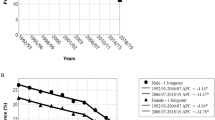Abstract
This paper uses recent US state-level data to examine smoking behavior across four population groups divided by age, literacy, income and ethnicity. Another contribution lies in the consideration of various smoking control policies and the full costs of smoking. Overall, the results show that non-price smoking policies are relatively more effective than price or tax policies in reducing smoking prevalence and that these policies gain effectiveness as the population begins to age.
Similar content being viewed by others
Notes
Higher income individuals are also generally likely to be more educated and to have health insurance coverage.
This study uses cross-sectional data to estimate the determinants of smoking prevalence. With appropriate data, one could estimate the demand for cigarettes through various other methods such as rational-addiction models (see Becker and Murphy 1988).
We also had data on black, Asian and Native American smokers. However, missing observations in these cases resulted in too few degrees of freedom to yield meaningful results.
Specifically, POLICYwork includes survey responses to whether there were smoking bans in common indoor areas and in work areas and POLICYhome includes instances where smoking was banned in the respondents’ homes (see CDC for details).
CONTROL is a more general measure than POLICYwork and POLICYhome as it includes smoking-related health education and cessation assistance. Furthermore, some POLICYwork and most POLICYhome are likely to be voluntary and not necessarily state-mandated.
However, the success of some initiatives like smoking cessation programs is somewhat suspect due to high relapse rates.
Details are available upon request.
See Townsend (1987) for the responsiveness of smokers across different social classes to tax changes in the UK.
Varying insurance coverages between the two groups (e.g., personal health insurance, public insurance or group insurance) might affect the extent to which individuals feel the immediate effects of higher medical costs.
Details are available upon request.
The effectiveness of workplace smoking restrictions has been noted in the literature. For example, Fichtenberg and Glantz (2002) conduct a meta-analysis of evidence from Australia, Canada, Germany and the USA and find support for the effectiveness of smoke-free workplaces, both in their impacts on smokers and on non-smokers. Also see Chaloupka and Saffer (1988) for a study of the USA and Wakefield et al. (1992) for Australia.
An important caveat to keep in mind, however, is that we are unable to measure smoking intensity by distinguishing between heavy and casual (occasional) smokers.
References
Baltagi BH, Levin D (1986) Estimating dynamic demand for cigarettes using panel data: the effects of bootlegging, taxation and advertising reconsidered. Rev Econ Stat 68:148–155
Becker G, Murphy K (1988) A theory of rational addiction. J Polit Econ 96:675–700
Cameron S (1998) Estimating the demand for cigarettes: a review of the literature. Econ Issues 3:51–72
Centers for Disease Control and Prevention (CDC) (2000) Reducing tobacco use: a report of the Surgeon General. US Department of Health and Human Services, Centers for Disease Control and Prevention, Office on Smoking and Health, Atlanta, GA
Chaloupka FJ, Saffer H (1988) The demand for cigarettes and restrictions on smoking in the workplace. National Bureau of Economic Research, Working paper No. 2663
Chaloupka FJ, Warner KE (2000) The economics of smoking. In: Culyer AJ, Newhouse JP (eds) Handbook of health economics, vol 1B. North-Holland, Amsterdam, pp 1539–1627
European Commission (2006) Attitudes of Europeans towards tobacco. http://ec.europa.eu/public_opinion/archives/ebs/ebs_239_en.pdf, January 2006
Fichtenberg CM, Glantz SA (2002) Effect of smoke-free workplaces on smoking behaviour: systematic view. Br Med J 325:188–191
Gallet CA, List JA (2003) Cigarette demand: a meta-analysis of elasticities. Health Econ 12:821–835
Goel RK, Nelson MA (2005) Tobacco policy and tobacco use: differences across tobacco types, gender and age. Appl Econ 37:765–771
Goel RK, Nelson MA (2006) The effectiveness of anti-smoking legislation: a review. J Econ Surv 20:325–355
Jha P, Ranson MK, Nguyen SN, Yach D (2002) Estimates of global and regional smoking prevalence in 1995, by age and sex. Am J Public Health 92:1002–1006
Max W (2001) The financial impact of smoking on health-related costs: a review of the literature. Am J Health Promot 15:321–331
Ramsey JB, Schmidt P (1976) Some further results on the use of OLS and BLUS residuals in specification error tests. J Am Stat Assoc 71:389–390
Townsend JL (1987) Cigarette tax, economic welfare, and social class patterns of smoking. Appl Econ 19:355–365
Townsend J, Rederick P, Cooper J (1994) Cigarette smoking by socioeconomic group, sex and age: effect of price, income, and health publicity. Br Med J 309:923–927
Wakefield MA, Wilson D, Owen N, Esterman A, Roberts L (1992) Workplace smoking restrictions, occupational status, and reduced cigarette consumption. J Occup Med 34:693–697
Yurekli AA, Zhang P (2000) The impact of Clean Indoor-Air Laws and cigarette smuggling on demand for cigarettes: an empirical model. Health Econ 9:159–170
Author information
Authors and Affiliations
Corresponding author
Additional information
Insightful comments of a referee and research assistance of Rebecca Hodel and Jim Saunoris are appreciated. Support of the Katie School of Insurance is gratefully acknowledged.
Appendix
Appendix
Table 6
Rights and permissions
About this article
Cite this article
Goel, R.K. Smoking prevalence in the United States: Differences across socioeconomic groups. J Econ Finan 32, 195–205 (2008). https://doi.org/10.1007/s12197-007-9013-3
Published:
Issue Date:
DOI: https://doi.org/10.1007/s12197-007-9013-3




